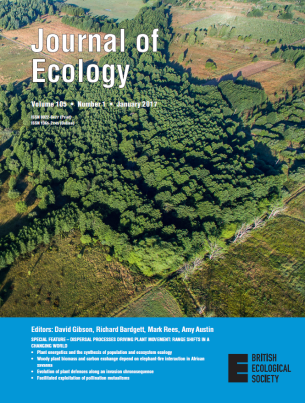Journal of Ecology published a Special Feature in issue 105.1 titled; Dispersal Processes driving plant movement: Range shifts in a changing world. One of the guest editors, Cristina García, tells us more about the Special Feature below…
 Most living organisms need to mobilise their propagules to avoid inter-specific competition, escape suboptimal or poor local conditions and colonise suitably remote sites. Dispersal is particularly challenging for sessile organisms, such as plants that typically get dispersed across the landscape by disseminating their seeds. Dispersal has long fascinated ecologists and distinguished naturalists, such as Darwin and Wallace, who have invoked dispersal and migration processes to explain biogeographic patterns.
Most living organisms need to mobilise their propagules to avoid inter-specific competition, escape suboptimal or poor local conditions and colonise suitably remote sites. Dispersal is particularly challenging for sessile organisms, such as plants that typically get dispersed across the landscape by disseminating their seeds. Dispersal has long fascinated ecologists and distinguished naturalists, such as Darwin and Wallace, who have invoked dispersal and migration processes to explain biogeographic patterns.
In an increasingly managed and fragmented world, constrained plant dispersal ability limits the chances of plant populations to persist and expand. We already have empirical evidence on the important role that local adaptation plays in organisms to cope with climate change, either through genetic or phenotypic changes, but we do not fully understand the impact of modifying the dispersal ability of plant populations to keep pace with fast global change. This was one of the fruitful discussions I had with my colleagues Etienne Klein and Pedro Jordano within the framework of our ongoing project EXPANDTREE and we decided to extend this theme to other researchers and colleagues interested in investigating from the lasting outcomes of modifying dispersal ability.
After submitting a proposal to the BES, we were granted the opportunity to organise a Thematic Topic session at the BES Annual Meeting 2015 in Edinburgh. This was a great chance for us to team up with different ecologists and evolutionary biologists to talk over dispersal and distribution range shifts. (By the way, if you are considering submitting a proposal for the next Annual Meeting you still have until 24th February 2017.) That session, and all the discussion generated around it, was the origin of this Special Feature that came out in issue 105.1 of Journal of Ecology.
In spite of the wealth of dispersal studies, there is still no consensus on basic issues such as what exactly long distance (LDD) dispersal is, or what is the best tool to obtain robust estimates on their frequency and extent. LDD events underlie population expansion, allows close species to hybridise, and triggers the fast expansion of invasive species, hence the importance of having a robust, accurate, and quantitative definition for what we mean when we talk about LDD. The paper by Jordano (2016) nicely clarifies the definition of LDD events by merging both the demographic and the genetic aspects inherent to any dispersal event. By doing so, the paper provides a taxonomy of different types of LDD events as a function of the dispersal distances and the genetic neighbourhoods reached by dispersed propagules.
Additionally, we are aware that dispersal ecologists require novel tools and models to quantify how far individuals move or to test for consequences of pollen and seed dispersal. Thus, Bullock et al. (2016) contributed a comprehensive review of widely used dispersal distribution functions used to analyse dispersal data and García & Borda-de-Água (2016) proposed the application of statistics of extremes to infer the probability and magnitude of LDD events.
Furthermore, Robledo-Arnuncio & Gaggiotti (2016) and Gerzabek et al. (2016) both use molecular marker data to reconstruct dispersal events and raise conclusions about contemporary migration rates and/or dispersal kernels. Additionally, Klein et al. (2016) investigated the probability of hybridization between two closely related species that inhabit the same landscape by modelling pollen dispersal under different spatial scenarios.
 We also felt it important to include contributions about the impact of the anthropic activity on the dispersal ability of plant species. Thus, Farwig et al. (2016) specifically addressed the effects of habitat fragmentation on seed removal by frugivorous birds and mammals in relation to species-specific responses to habitat disturbance, whereas Horvitz et al. (2016) provided empirical data on the spread of 17 invasive plant species in China, that points to the unequivocal role of human-assisted dispersal.
We also felt it important to include contributions about the impact of the anthropic activity on the dispersal ability of plant species. Thus, Farwig et al. (2016) specifically addressed the effects of habitat fragmentation on seed removal by frugivorous birds and mammals in relation to species-specific responses to habitat disturbance, whereas Horvitz et al. (2016) provided empirical data on the spread of 17 invasive plant species in China, that points to the unequivocal role of human-assisted dispersal.
Regarding further research into dispersal, the increasing availability of monitoring data movement through genetic and genomic tools or sophisticated GPS-devices is greatly contributing to improving our understanding of this fundamental biological process. For example, monitoring programs and big data are expected to assist the forecasting of distribution range shifts under different scenarios of climate change. I am sure that this and other fascinated topics related to dispersal will centre the discussion of forthcoming Thematic Topics and, eventually, new Special Features.
Cristina García, CIBIO/InBIO




Reblogged this on Probioknowledge and commented: